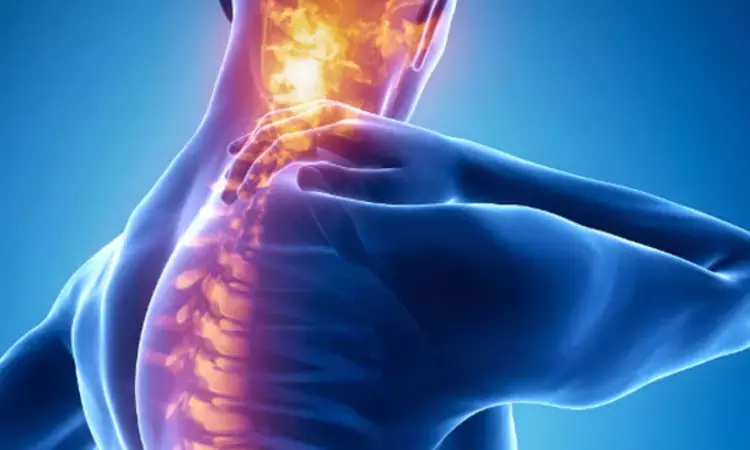- Home
- Medical news & Guidelines
- Anesthesiology
- Cardiology and CTVS
- Critical Care
- Dentistry
- Dermatology
- Diabetes and Endocrinology
- ENT
- Gastroenterology
- Medicine
- Nephrology
- Neurology
- Obstretics-Gynaecology
- Oncology
- Ophthalmology
- Orthopaedics
- Pediatrics-Neonatology
- Psychiatry
- Pulmonology
- Radiology
- Surgery
- Urology
- Laboratory Medicine
- Diet
- Nursing
- Paramedical
- Physiotherapy
- Health news
- Fact Check
- Bone Health Fact Check
- Brain Health Fact Check
- Cancer Related Fact Check
- Child Care Fact Check
- Dental and oral health fact check
- Diabetes and metabolic health fact check
- Diet and Nutrition Fact Check
- Eye and ENT Care Fact Check
- Fitness fact check
- Gut health fact check
- Heart health fact check
- Kidney health fact check
- Medical education fact check
- Men's health fact check
- Respiratory fact check
- Skin and hair care fact check
- Vaccine and Immunization fact check
- Women's health fact check
- AYUSH
- State News
- Andaman and Nicobar Islands
- Andhra Pradesh
- Arunachal Pradesh
- Assam
- Bihar
- Chandigarh
- Chattisgarh
- Dadra and Nagar Haveli
- Daman and Diu
- Delhi
- Goa
- Gujarat
- Haryana
- Himachal Pradesh
- Jammu & Kashmir
- Jharkhand
- Karnataka
- Kerala
- Ladakh
- Lakshadweep
- Madhya Pradesh
- Maharashtra
- Manipur
- Meghalaya
- Mizoram
- Nagaland
- Odisha
- Puducherry
- Punjab
- Rajasthan
- Sikkim
- Tamil Nadu
- Telangana
- Tripura
- Uttar Pradesh
- Uttrakhand
- West Bengal
- Medical Education
- Industry
Study reveals high incidence of neuropathic pain in patients with type 1 diabetes

USA: A recent study published in Diabetes Care has revealed a staggeringly high cumulative incidence of neuropathic pain (NP) in patients with type 1 diabetes (T1D), irrespective of clinical signs of diabetic peripheral neuropathy (DPN).
The study also identified female sex and HbA1c levels to be linked with neuropathic pain without clinical signs of DPN. These findings call for an urgent need for effective clinical strategies to manage neuropathic pain in this patient population, the researchers stated.
Diabetic peripheral neuropathy is common; however, the burden and features of NP in type 1 diabetes are poorly understood. Therefore, Barbara H. Braffett, Biostatistics Center, The George Washington University, Rockville, MD, and colleagues evaluated the incidence of annual prevalence, first occurrence, remission, and risk factors for NP during long-term follow-up of patients with T1D.
For this purpose, the researchers administered the Michigan Neuropathy Screening Instrument (MNSI) (1994–2020) to 1,324 participants in the Epidemiology of Diabetes Interventions and Complications (EDIC) study. Neuropathic pain with clinical signs of DPN (NP DPN+) was identified according to self-reported NP plus an examination score >2, and NP without DPN's clinical signs was identified according to self-reported NP and an examination score ≤2.
The study led to the following findings:
- At EDIC year 1, the median age for participants was 36 years, diabetes duration 13 years, and HbA1c 7.9%.
- At year 26, the cumulative incidence of NP was 57%, regardless of concomitant clinical signs of DPN (36% NP DPN+ vs. 46% NP DPN−).
- NP prevalence was 20% at 26 years (11% NP DPN+ and 9% NP DPN−), suggesting frequent remission.
- Annualized remission rates were similar regardless of pain medication use.
- In addition to HbA1c, female sex was associated with NP DPN−.
"Our results showed a high incidence of neuropathic pain in type 1 diabetes that frequently occurred in the absence of clinical signs of neuropathy, as assessed with MNSI," the researchers wrote. "Pain remission was not explained by pain medication use."
"There is a need for effective clinical strategies for identification and management," they concluded.
Reference:
Braffett BH, El Ghormli L, Albers JW, Feldman EL, Herman WH, Gubitosi-Klug RA, Martin CL, Orchard TJ, White NH, Lachin JM, Perkins BA, Pop-Busui R; DCCT/EDIC Research Group. Neuropathic Pain With and Without Diabetic Peripheral Neuropathy in Type 1 Diabetes. Diabetes Care. 2024 Feb 1:dc231749. doi: 10.2337/dc23-1749. Epub ahead of print. PMID: 38300889.
Dr Kamal Kant Kohli-MBBS, DTCD- a chest specialist with more than 30 years of practice and a flair for writing clinical articles, Dr Kamal Kant Kohli joined Medical Dialogues as a Chief Editor of Medical News. Besides writing articles, as an editor, he proofreads and verifies all the medical content published on Medical Dialogues including those coming from journals, studies,medical conferences,guidelines etc. Email: drkohli@medicaldialogues.in. Contact no. 011-43720751


